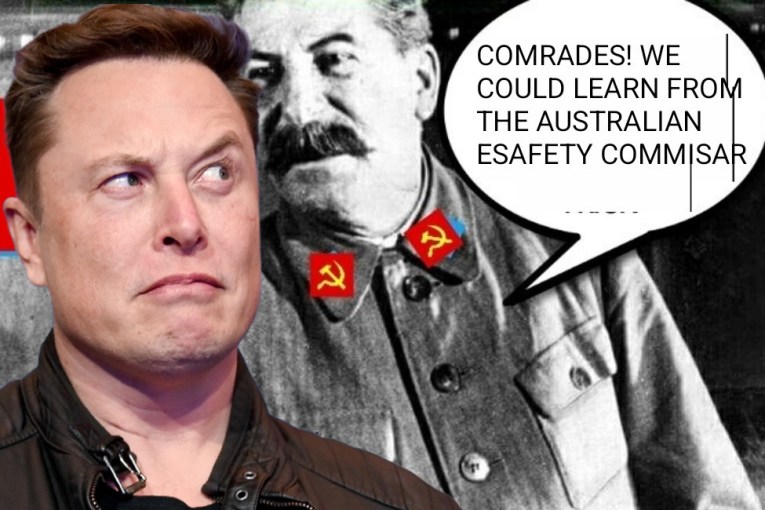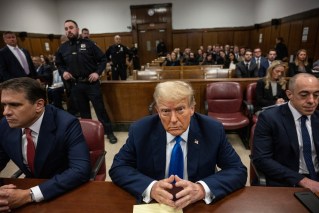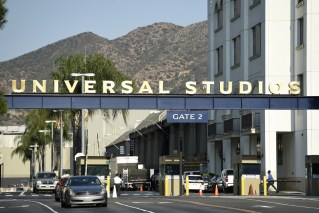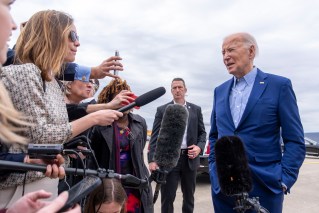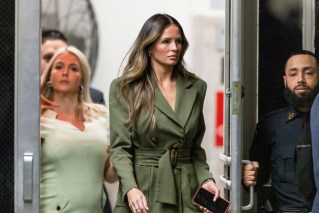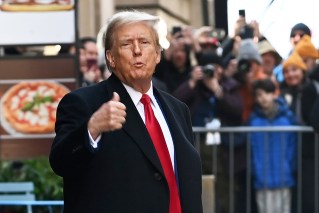Killings by police mount throughout trial over George Floyd’s death
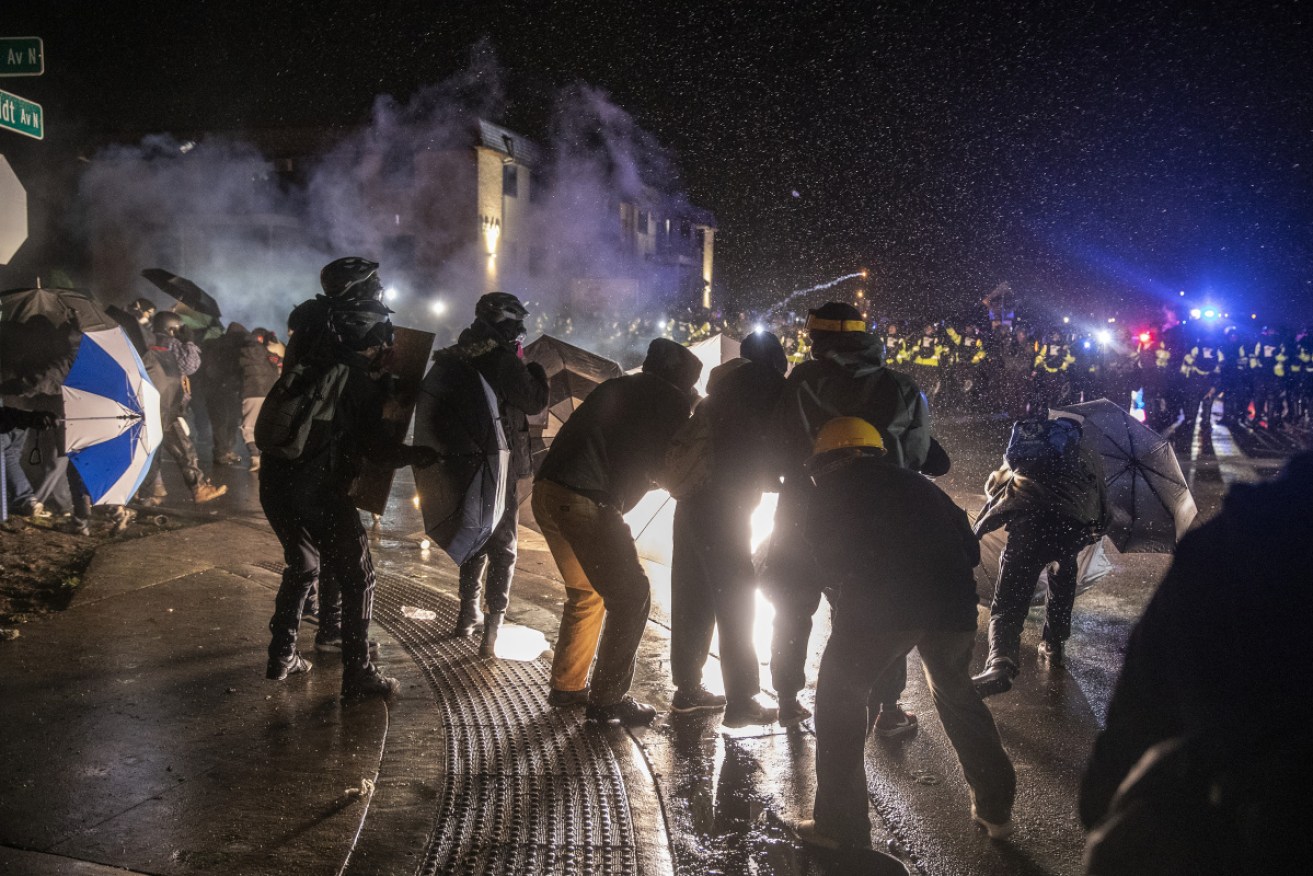
Protesters are illuminated by a flash bang grenade during a clash with law enforcement officers near the Brooklyn Centre Police Department. Photo: NYT
Just seven hours before prosecutors opened their case against Derek Chauvin, a former Minneapolis police officer charged with killing George Floyd, a Chicago officer chased down a 13-year-old boy in a West Side alley and fatally shot him as he turned with his hands up.
One day later, at a hotel in Jacksonville, Florida, officers fatally shot a 32-year-old man who, police say, grabbed one of their Tasers.
The day after that, as an eyewitness to Floyd’s death broke down in a Minneapolis courtroom while recounting what he saw, a 40-year-old mentally ill man who said he was being harassed by voices was killed in Claremont, New Hampshire, in a shootout with the state police.
On every day that followed, all the way through the close of testimony, another person was killed by the police somewhere in the United States.
The trial has forced a traumatised country to relive the gruesome death of Floyd beneath Chauvin’s knee.
But even as Americans continue to process that case – and anxiously wait for a verdict – new cases of people killed by the police mount unabated.
Since testimony began March 29, at least 64 people have died at the hands of law enforcement nationwide, with Black and Latino people representing more than half of the dead.
As of Saturday, the average was more than three killings a day.

Katie Wright, the mother of Daunte Wright, 20, who was shot and killed during a traffic stop by police. Photo: NYT
The deaths, culled by The New York Times from gun violence databases, news media accounts and law enforcement releases, offer a snapshot of policing in America in this moment.
They testify not only to the danger and desperation that police officers confront daily but also to the split-second choices and missteps by members of law enforcement that can escalate workday arrests into fatalities.
They are the result of domestic violence calls, traffic stops gone awry, standoffs and chases.
The victims often behave erratically, some suffering from mental illness, and the sight of anything resembling a weapon causes things to escalate quickly.
And their fallout has been wrenchingly familiar, from the graphic videos that so often emerge to the protests that so often descend into scuffles between law enforcement and demonstrators on streets filled with tear gas.
Just as one community confronts one killing, another happens.
Across the spectrum, from community activists to law enforcement personnel, there is emotional and mental exhaustion – and the feeling that the nation cannot get this right.
“How many more losses must we mourn?” Miski Noor, co-executive director of the Minneapolis-based activist group Black Visions, said in a statement after the killing of Daunte Wright, 20, during a recent traffic stop in Brooklyn Centre, Minnesota.
The pain of Floyd’s death “is still scarred into our minds and yet history continues to repeat itself,” the statement continued.
“Our community has reached its breaking point.”
This past week the mayor of Chicago called for calm as “excruciating” body camera footage was released in the police killing of the 13-year-old, Adam Toledo.
The shaky video shows a police officer, responding to a call of shots fired, chasing a boy with what appears to be a gun down an alley at night in a predominantly Latino neighbourhood.
“Stop right now!” the officer screams while cursing. “Hands. Show me your hands. Drop it. Drop it.” A single shot fells the boy as he turns, lifting his hands.
Other recent lethal force incidents have rocked communities large and small: Michael Leon Hughes, 32, a Black man shot to death March 30 after, police say, he used a Taser on a Jacksonville police officer responding to a domestic dispute in a motel; Iremamber Sykap, 16, a Pacific Islander killed on April 5 as he fled from the Honolulu police in a stolen Honda Civic; and Anthony Thompson Jr, 17, a Black teenager in Knoxville, Tennessee, killed by the police April 12 in a high school bathroom after reports that a student had brought a gun onto campus.

Air fresheners hung by protesters after Daunte Wright was fatally shot by an officer. Photo: NYT
All of those killings and many more occurred as testimony in the Minneapolis trial unfolded, though few attracted as much national attention as the shooting of Wright less than 10 miles from the courthouse where Chauvin stood trial.
Protests erupted in Brooklyn Centre after a veteran police officer fatally shot Wright, saying she mistook her gun for her Taser as he attempted to flee during a traffic stop.
Although many of these killings have a familiar ring, it is unfair to blame them all on law enforcement, said Patrick Yoes, a retired sheriff’s office captain and president of the national Fraternal Order of Police.
“In a lot of cities, it has to do with people feeling hopeless,” he said.
“It’s poverty. It’s a failing education system. It’s all of these things that are vitally important to stability of a community.”
That instability often places officers in situations in which they confront individuals who may be dangerous and noncompliant, he said.
Part of the reason society has been unable to prevent deadly encounters between law enforcement and the community is that some people are unwilling to discuss the real challenges of crime that officers sometimes encounter, he said.
“There’s just so many factors that people have already made up their minds and they think that law enforcement is based off of race,” said Yoes, who is white.
Federal and state laws generally hold that officers are justified in using lethal force as long as they have a “reasonable” fear of “imminent” injury or death for themselves or another person.
And jurors tend not to second-guess what might be “reasonable” force in the moment.
Of the 64 fatal encounters compiled by the Times for the past three weeks, at least 42 involved people accused of wielding firearms.
More than a dozen involved confrontations with people who were mentally ill or in the throes of a breakdown. And at least 10 arose as the police responded to reports of domestic violence.
Some dispute the notion that danger, rather than bias, is more likely to drive a law enforcement officer’s reactions.
“What I see sometimes is, in these encounters with people of colour, there is a different aggression,” said Ron Johnson, a retired Missouri State Highway Patrol captain who led the police response in Ferguson, Missouri, after the police killing of Michael Brown in 2014.
“This adrenaline starts going out of the roof,” added Johnson, who is Black.
“And why? It’s because we don’t have these experiences and these understandings of each other. And in some cases, it’s about humanity. We don’t see them in the same human way that we see ourselves.”
Since at least 2013, with a slight dip because of the pandemic, about 1100 people have been killed each year by law enforcement officers, according to databases compiled by Mapping Police Violence, a research and advocacy group that examines all such killings, including non-gun-related deaths such as Floyd’s.
The Washington Post, whose numbers are limited to police shootings, reflect a similarly flat trend line.
Nearly all the victims since March 29 have been men, with Black or Latino people substantially overrepresented – a pattern that reflects broader criminal justice research. And most were younger than 30. Four were teenagers.
Philip Stinson, a professor in the criminal justice program at Bowling Green State University who studies civilian killings by members of law enforcement, said the most striking aspect of the statistics on lethal police force is how little the numbers have changed in the decade or two since researchers began to comprehensively track them.
Even as mobile phone videos and body cameras make it harder to hide human error and abuses of authority by law enforcement – and even as social media amplifies public outrage – only about 1.1 per cent of officers who kill civilians are charged with murder or manslaughter, Professor Stinson said.
Since the beginning of 2005, he said, 140 nonfederal sworn law enforcement officers – such as police officers, deputy sheriffs and state troopers – have been arrested on charges of murder or manslaughter resulting from an on-duty shooting.
Of those, 44 have been convicted of a crime resulting from the incident, in most cases for a lesser offence.
That could be because many of the shootings are legally justified – or also, as Professor Stinson believes, because the legal system and laws themselves are overly deferential to the police.
That deference, he added, protects the status quo in the more than 18,000 law enforcement agencies across the country.
“All law enforcement is local,” he said.
“Culture eats policy, as the saying goes, and we have a police subculture whose core elements in many places include a fear of Black people.”
-NYT
